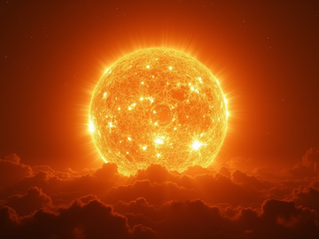Exoplanets are Discovered in Pleiades. The Ultimate Guide to Exoplanets
- Phystroid
- Sep 7, 2019
- 6 min read
Updated: Feb 27, 2023
A beautiful discovery, near these bright and famous stars, also known as the 7 sisters or M45.

Since 1995, when the first exoplanet was discovered, more than 4,000 planets outside our solar system have been discovered. However none of them has the special characteristics that Earth has. None of them is a relatively small, rocky planet at the proper distance from the star that allows the existence of water in liquid state.
However the most common type of exoplanets is gaseous planets like Jupiter. For this reason, it is a very special moment when, new rocky planets are discovered. Also small rocky planets are harder to discover due to their brightness. For this reason it is important that astronomers have detected an area around the star HD23514, in the stellar cluster of the seven sisters (Pleiades) or M45, (which is easily visible in the night sky at the constellation of Taurus), where rocky planets are created, or already have been created.
The star cluster of Pleiades was named after the 7 daughters of Atlas, (a mythic titan of Greek mythology). The cluster has more than 1000 stars and is at a distance of more than 400 light years away. With the Spitzer telescope as well as with the Gemini telescope in Hawaii astronomers have discovered that one of the stars in the cluster has age 100 million years and is surrounded by a cloud of hot dust particles, thousands times bigger than the cloud that is around our sun. The name of this star is HD23534. The warm emissions that our telescopes have detected, come from dust that is around the star at a distance of 0, 25-2 A U. These emissions are on the infrared and suggest violent and massive collisions in a young planetary system which is at the first stages of its evolution. The presence of so much dust suggests collisions of protoplanets (maybe of two rocky planets at the Earth’s size), like our Earth’s collision with an object at the size of Mars which created the Moon.
But there is also an important question that must be answered here. How could someone distinguish if this dust is a part of the primordial dust that remained after the creation of the star or if it is a result of collisions between rocky planets? We may consider the age of HD23514. Usually “newborn” young stars with age of about 10 million years still have a disk of gas and dust. However, by the time a star is 100 million years old (like HD23514), the dust has dissipated because the dust particles are blown away or dragged onto the star, or even the particles clump together to form larger objects. For this reason the infrared emissions that have been detected can only be collisions between rocky planets.
There are several methods of detecting an exoplanet; the oldest method is astrometry, where a precise measurement of the stars position in the sky is taken over a period of time. The most productive method is by using the radial velocity of a star as it comes towards or away from Earth and measuring the Doppler shift in the result. Both these methods rely on the fact that the star will have its own orbit or ‘wobble’ due to the orbiting planet.
Another popular method is the transit method where you observe the intensity of a stars light over time and plot it as a light curve, as the planet crosses in front of the star it blocks out some of the light and the intensity decreases. The major set back for ground based astronomy is the restless atmosphere which significantly affects the accuracy of data taken. In the radial velocity method, ground based spectroscopes can measure Doppler shifts greater than 3 m/sec, this Doppler shift corresponds to a minimum detectable mass of for a planet at 1 AU from a 1 solar mass star where is the inclination of the orbital pole to the line of sight, although this method is limited to Main Sequence stars of spectral classes F to M. The minimum detectable mass increases as the square root of the planets orbital size.
The first exoplanet to be discovered around a solar-type star was found by the Geneva Extrasolar Planet Search Programme. They had three different surveys: ELODIE, CORALIE and M-Dwarf who all use the radial velocity method to find exoplanets. ELOPIE surveys the Northern sky from the Haute-Provence Observatory in France, CORALIE surveys the Southern sky from La Silla Observatory in Chile and M-Dwarf uses the OHP to search for planets orbiting M-Dwarf stars. The first exoplanet to be found orbiting a Sun-like star was discovered by the ELOPIE survey in 1995, object 51 Pegasi.
The Keck Interferometer, was an American Project with their observatory located on the Mauna Kea volcano in Hawaii. They use two 10 m telescopes, the world’s largest optical and infrared telescopes, to measure emission from dust orbiting nearby stars to search for regions in which Earth-like planets may have formed. In doing so they identified regions in space which are best for the space borne missions to examine.
Having the use of the two telescopes is extremely beneficial as their interaction is
used to cancel out the blinding glare of nearby bright stars and it also makes
measuring distances and angles more accurate. The Keck telescopes were capable of measuring angles as small as 20 micro arc seconds, this angle corresponds to a minimum measurable mass of whereas space borne telescopes can measure angles ten times as small and therefore a ten times smaller planet can be found.
The Future of Ground Based Extra solar planet discovery: Improving Exoplanet Discovery
The simplest way to improve our chances of finding extra solar planets is to build
larger observatories. The larger the aperture (mirror size) the greater the resolution of the telescope which allows for observations in greater detail and improving our
understanding of extra solar planets. Possibly the most exciting project which will
improve exoplanet discovery and knowledge is the European Extremely Large
Telescope, or the E-ELT. This telescope is the largest with funding planned for the
near future with exoplanet research being among its main objectives. Although the operating costs are high, they are still significantly lower than that of much smaller space observatories, making these large ground based plans very useful.
The E-ELT will allow for direct imaging of exoplanets thanks to its 42 meter-diameter mirror and adaptive optics systems which provide it with an angular resolution of 0.001 – 0.6 arc seconds. The original idea was to build a 100 meter telescope but this was dismissed for being too complex. Direct imaging is not the easiest way to find exoplanets but it is a good way to study catalogued exoplanets, so the E-ELT could pick through the current exoplanet catalogue and hopefully tell us more about things like the atmospheres of exoplanet. The E-ELT is the only major telescope with extra solar planet discovery and study as main objectives.
Why Ground Based Observatories Are Worth While
Since the invention of the telescope the quality of image has always been subject to
the Earth’s atmosphere and its conditions. This effect is called seeing as limits the
resolution to around 1 arc second for any telescope on the ground. Seeing is the
variation of density in the Earth’s atmosphere, cells are formed which make an image appear as if it is twinkling. Space telescopes do not suffer from this phenomenon as they are in orbit; however they always come at a disadvantage as there is a strict limit as to the size of the telescope due to launch capabilities. Ground based observatories can get around this problem to some degree by using adaptive optics, and the better this system is the better the resolution of the telescope. There are several ways adaptive optics works, one of which is by using a laser guide star to monitor the seeing effect. A computer measures the effects of seeing and attempts to correct for it by distorting the mirror to its optimal shape. This system is crucial for searching for extra solar planets far away from our own solar system. The E-ELT will need a very sophisticated adaptive optics system as it will be built in segments, and therefore will require several adaptive optics systems that all work in line with each other, however if accomplished the E-ELT would be able to see far more than any current space based telescope.





























